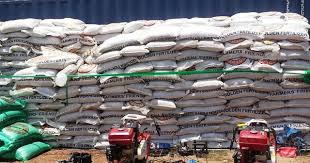Can the digital revolution transform agriculture?
The world talks a lot about the digital revolution, but few
connect it to the coming agriculture revolution, especially in Africa. Digital
solutions have huge potential for helping farmers boost productivity and
connect to financial tools and markets around the world.
Farming in the plains of northern Nigeria around Abuja
requires tedious manual labor because of the lack of farm machinery. A few days
of tractor use for farmers in this region could improve productivity by 20 to
40 times. However, farmers cannot afford to buy a tractor in remote rural areas
of Africa. Jehiel Oliver, founder of Hello Tractor, thought that an Uber-like
tractor service might be a solution. “Our booking system allows farmers to
conveniently request, schedule, and prepay for tractor services from nearby
smart tractor owners, through text messaging and mobile money. Once service is
completed, the prepayment is automatically released to the smart tractor
owner,” explains Oliver. His smart two-wheel tractors are equipped with GPS
antennae that collect and transfer necessary data. The system helps to reduce
tractor costs, raising farm productivity and generates additional income.
These types of innovations have the potential to affect
developed countries. Whereas the number of tractors in Nigeria may be
insufficient, Switzerland and Germany have a luxury problem: too many
under-used tractors. But in cases of both over and under supply, tractor (and
car) use could be greatly optimized using digital services.
Figure 1: Number of tractors per 10,000 hectare of arable
land (2007)
Nigeria 7
United States 276
Switzerland 2,611
Source: FAO
The core innovation for farmers is that services and money
can now be exchanged digitally, a revolution that has been spearheaded in Kenya
with mobile money platforms like M-PESA. Mobile money has been so successfully
introduced that there is more money on mobile phones today than in the whole
banking system of the country with a quarterly volume of $10 billion and 20
million subscribers. M-PESA enables its users to deposit and withdraw money,
and transfer money to other users, for example, like agri-input dealers. With
3.5 billion cell phones currently in the world, these services have quickly
disseminated to other countries.
In Australia, farmers are herding cattle via cell phones.
Boundaries are enforced by electrical prompts from transponders on individual
cattle collars. The signal comes from a farm base station linked to GPS
tracking. Grazing zones can be enabled and controlled by an app. It’s easy to
imagine how this technology greatly reduces labor and material costs of cattle
herding.
The digital revolution could also improve the lives of
farmers and consumers, especially in reducing wasted time and resources while
enhancing productivity. People in rural areas who previously were not able to
access banks can now make and received money transfers at low costs.
There are more benefits. Technology may greatly improve food
safety in value chains. For instance, consumers in China do not trust domestic
food producers. Too many food scandals in the past have undermined consumers
trust. That’s why IBM, Walmart, and the Chinese retailer JD.com together with
Tsinghua University have announced a blockchain food safety alliance to improve
food tracking and safety in China. Decentralized ledger technology can trace
back the origin of food products in a few seconds instead of a few weeks,
making it easier to combat fraud.
Combining big data and digital technology will change the
way of doing agribusiness. In the past, suppliers of fertilizers, plant
protection products, agriculture machinery, and seeds aimed to increase sales.
Changing consumption patterns (25 percent of Europeans are vegan sympathetic
and reduce animal protein in their diets) and declining population growth will
most likely change the current business model of global agribusiness. “Before,
selling more products meant more business for a company like Bayer; whereas in
future, the fewer products we sell the better, because we’re selling outcome
based services. With sensor devices, we can learn a lot more about what is and
is not helping crops and livestock and create a better way of doing things,”
says Tobias Menne, head of Bayer’s Digital Farming.
Ultimately, farmers need the most appropriate fertilizers
and plant protection products for their location. This mandates the existence
of local agri-input dealers who can reach farmers and provide advice and input
tailored to farmer needs in partnership with global players. The Farm Shop
franchising network in Kenya, for example, now reaches small farmers who
previously were challenged in securing appropriate advice and inputs.
Alex Lissitsa, CEO of IMC in Ukraine, is constantly testing
and introducing digital solutions for the company’s farming operations. He
knows at any time where the agriculture machinery is working by using
GPS-monitoring systems. IMC’s agronomists steer drones over their fields to
differentiate the use of seeds and fertilizers to the needs of specific tiny
plots.
What’s more, less input and higher productivity solutions
like these will make farming climate smarter. About 24 percent of carbon
emission equivalents come from agriculture. Digital solutions and big data may
enable climate funds to invest in small, remote, and disconnected smallholders
applying climate-smart farm and irrigation practices to mitigate and adapt to
climate change.
Finally, governments can improve farming scientific research
and education. Artificial intelligence, like chatbots, may greatly improve and
reduce the costs of educating and informing farmers. Farmers may be able to
quickly get practical answers to questions, for example, about animal diseases,
animal health, and vaccination in livestock production, and crop diseases,
plant protection, and optimal seeding and harvest times in crop production.
Even subsidies may be distributed better with less costs and risks of misuse.
While these innovations only scratch the surface of the
coming digital revolution, it’s clear that digital solutions will transform
agriculture with great benefits for smallholders.
Source: brookings.edu




Comments
Post a Comment